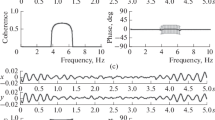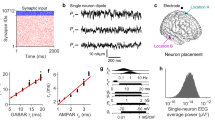Abstract
We present an empirical model of the electroencephalogram (EEG) signal based on the construction of a stochastic limit cycle oscillator using Itô calculus. This formulation, where the noise influences actually interact with the dynamics, is substantially different from the usual definition of measurement noise. Analysis of model data is compared with actual EEG data using both traditional methods and modern techniques from nonlinear time series analysis. The model demonstrates visually displayed patterns and statistics that are similar to actual EEG data. In addition, the nonlinear mechanisms underlying the dynamics of the model do not manifest themselves in nonlinear time series analysis, paralleling the situation with real, non-pathological EEG data. This modeling exercise suggests that the EEG is optimally described by stochastic limit cycle behavior.
Similar content being viewed by others
References
Abarbanel HDI (1996) Analysis of observed chaotic data. Springer, Berlin Heidelberg New York
Arnhold J, Grassberger P, Lehnertz K, Elger C (1999) A robust method for detecting interdependencies: Application to intracranially recorded EEG. Physica D 134:419–430
Babloyantz A (1985) Strange attractors in the dynamics of brain activity. In: Haken H (ed) Complex systems operational approaches. Springer, Berlin Heidelberg New York
Babloyantz A, Destexhe A (1986) Low dimensional chaos in an instance of epilepsy. Proc Natl Acad Sci USA 83:3513–3517
Barlow JS (1993) The electroencephalogram: its patterns and origins. MIT Press, Cambridge, MA
Başar E (1990) Chaos in brain function. Springer, Berlin Heidelberg New York
Burke D (2003) An extensible C++ framework for stochastic differential equations. C/C++ Users J 21:12–17
Breakspear M, Terry JR (2002a) Detection and description of non-linear interdependence in normal multichannel human EEG data. Clin Neurophysiol 113:735–753
Breakspear M, Terry JR (2002b) Nonlinear interdependence in neural systems: motivation, theory, and relevance. Int J Neurosci 112:1263–1284
Casdagli M (1991) Chaos and deterministic versus stochastic non-linear modelling. J R Stat Soc B 54:303–328
Casdagli MC, Iasemidis LD, Savit RS, Gilmore RL, Roper SN, Sackellares JC (1997) Non-linearity in invasive EEG recordings from patients with temporal lope epilepsy. Electroencephalogr Clin Neurophysiol 102:98–105
Dewan EM (1964) Nonlinear oscillations and electroencephalography. J Theor Biol 7:141–159
Dumermuth G, Molinari L (1987) Spectral analysis of EEG background activity. In: Gevins AS, Remond A (eds) Methods of analysis of brain electrical and magnetic signals. EEG Handbook. Elsevier, Amsterdam
Freeman WJ (1975) Mass action in the nervous system. Academic, New York
Freeman WJ (2000) Spatial spectral analysis of human electrocorticograms including the alpha and gamma bands. J Neurosci Methods 95:111–121
Gard TC (1988) Introduction to stochastic differential equations. Marcel Dekker, New York
Gradisek J, Siegert S, Freidrich R, Grabec I (2000) Analysis of time series from stochastic processes. Phys Rev E 62:3146–3155
Grassberger P, Procaccia I (1983) Characterisation of strange attractors. Phys Rev Lett 50:346
Guckenheimer J, Holmes P (1983) Nonlinear oscillations, dynamical systems, and bifurcations of vector fields. Springer, Berlin Heidelberg New York
Hernández JL, Valdés PA, Vila P (1996) EEG spike and wave modelled by a stochastic limit cycle. Neuroreport 7:2246–2250
Kantz H, Schreiber T (1997) Nonlinear time series analysis. Cambridge University Press, Cambridge, UK
Kloeden PE, Platen E (1999) Numerical solution of stochastic differential equations. Springer, Berlin Heidelberg New York
Kugiumtzis D (2001) On the reliability of the surrogate data test for nonlinearity in the analysis of noisy time series. Int J Bifurcat Chaos 11:1881–1896
La Salle J, Lefschetz S (1961) Stability by liapunov’s direct method with applications. Academic, New York
Lehnertz K, Arnhold J, Grassberger P, Elger CE (1999) In: Proceedings of the workshop on chaos in brain, Bonn, Germany
LeVan Quyen M, Martinerie J, Adam C, Varela F (1999) Nonlinear analyses of interictal EEG map the interdependencies in human focal epilepsy. Physica D 127:250–266
Lopes Da Silva F, Hoeks A, Smits H, Zetterberg LH (1974) Model of brain rhythmic activity. Kybernetik 15:27–37
Niedermeyer E, Lopes da Silva F (1999) Electroencephalography: basic principles, clinical applications, and related fields. Lippincott Williams and Wilkins, Baltimore
Nunez PL (1995) Neocortical dynamics and human brain rhythms. Oxford University Press, New York
Nunez PL (2000) Toward a quantitative description of large-scale neocortical dynamic function and EEG. Behav Brain Sci 23:371–437
Øksendal B (1998) Stochastic differential equations: an introduction with applications. Universitext, Springer, Berlin Heidelberg New York
Pardey J, Roberts S, Tarassenko L (1996) A review of parametric modelling techniques for EEG analysis. Med Eng Phys 18:2–11
Pijn JP, Van Neerven J, Noest A, Lopes da Silva FH (1991) Chaos or noise in EEG signals: dependence on state and brain site. Electroencephalogr Clin Neurophysiol 79:371–381
Pritchard WS, Duke DW (1992) Measuring chaos in the brain: a tutorial review of nonlinear dynamical EEG analysis. Int J Neurosci 67:31–80
Pritchard WS, Duke DW, Krieble KK (1995) Dimensional analysis of resting EEG: II. surrogate data testing indicates nonlinearity but not low-dimensional chaos. Psychophysiology 32:486–491
Putten van MJAM, Stam CJ (2001) Is the EEG really chaotic in hypsarrhythmia? IEEE Eng Med Biol 20:72–79
Robinson PA, Wright JJ, Rennie CJ (1998) Synchronous oscillations in the cerebral cortex. Phys Rev E 57:4578–4588
Robinson PA, Rennie CJ, Wright JJ, Bahramali H, Gordon E, Rowe DL (2001) Prediction of electroencephalographic spectra from neurophysiology. Phys Rev E 63:1–18
Rombouts SARB, Keunen RWM, Stam CJ (1995) Investigation of nonlinear structure in multichannel EEG. Phys Lett A 202:352–358
Rotterdam van A, Lopes da Silva FH, van den Ende J, Viergever MA, Hermans AJ (1982) A model of spatio-temporal characteristics of the alpha rhythm. Bull Math Biol 44:283–305
Schreiber T, Schmitz A (2000) Surrogate time series. Physica D 142:346–382
Siegert S, Friedrich R, Peinke J (1998) Analysis of data sets of stochastic systems. Phys Lett A 243:275–280
Stam CJ, Pijn JPM, Suffczynski P, Lopes da Silva FH (1999) Dynamics of the human alpha rhythm: evidence for nonlinearity? Clin Neurphysiol 110:1801–1813
Theiler J (1986) Spurious dimensions from correlation algorithms applied to limited time-series data. Phys Rev A34:2427
Theiler J, Eubank S, Longtin A, Galdrikian B, Farmer JD (1992) Testing for nonlinearity in time series: the method of surrogate data. Physica D 58:77–94
Theiler J (1995) On the evidence for low-dimensional chaos in an epileptic electroencephalogram. Phys Lett A 196:335–341
Theiler J, Rapp PE (1996) Re-examination of the evidence for low-dimensional, nonlinear structure in the human electroencephalogram. Electroencephalogr Clin Neurophysiol 98:213–222
Theiler J, Eubank S, Longtin A, Galdrikan B, Farmer JD (1992) Testing for nonlinearity in time series: the method of surrogate. Physica D 58:77–94
Wilson HR, Cowan JD (1972) Excitatory and inhibitory interactions in localized populations of model neurons. Biophys J 12:1–24
Wilson HR, Cowan JD (1973) A mathematical theory of the functional dynamics of cortical and thalamic nervous tissue. Kybernetik 13:55–80
Wright JJ, Rennie CJ, Lees GJ, Robinson PA, Bourke PD, Chapman CL, Gordon E, Rowe DL (2003) Simulated electrocortical activity at microscopic, mesoscopic, and global states. Neuropsychopharmacology 28:580–593
Zetterberg LH (1977) Means and methods for processing of physiological signals with emphasis on EEG analysis. In: Lawrence JH (ed) Advances in biology and medical physics, vol 16. Academic, New York, pp 41–91
Author information
Authors and Affiliations
Corresponding author
Rights and permissions
About this article
Cite this article
Burke, D., de Paor, A. A stochastic limit cycle oscillator model of the EEG. Biol. Cybern. 91, 221–230 (2004). https://doi.org/10.1007/s00422-004-0509-z
Received:
Accepted:
Published:
Issue Date:
DOI: https://doi.org/10.1007/s00422-004-0509-z




